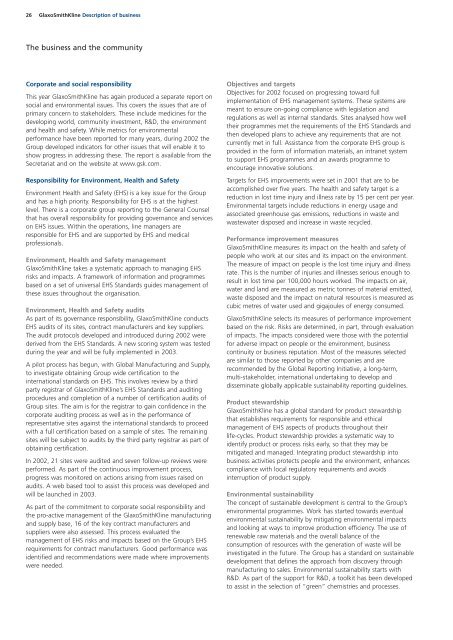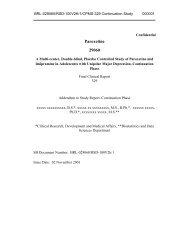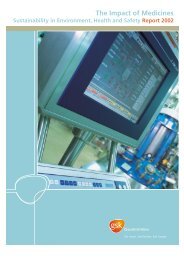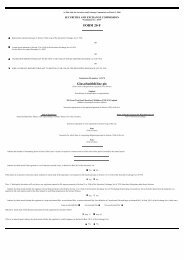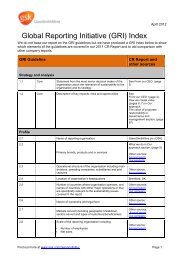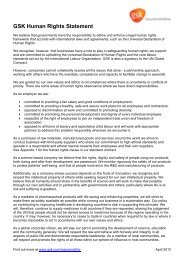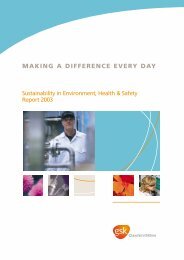GSK Annual Report 2002
GSK Annual Report 2002
GSK Annual Report 2002
You also want an ePaper? Increase the reach of your titles
YUMPU automatically turns print PDFs into web optimized ePapers that Google loves.
26 GlaxoSmithKline Description of business<br />
The business and the community<br />
Corporate and social responsibility<br />
This year GlaxoSmithKline has again produced a separate report on<br />
social and environmental issues. This covers the issues that are of<br />
primary concern to stakeholders. These include medicines for the<br />
developing world, community investment, R&D, the environment<br />
and health and safety. While metrics for environmental<br />
performance have been reported for many years, during <strong>2002</strong> the<br />
Group developed indicators for other issues that will enable it to<br />
show progress in addressing these. The report is available from the<br />
Secretariat and on the website at www.gsk.com.<br />
Responsibility for Environment, Health and Safety<br />
Environment Health and Safety (EHS) is a key issue for the Group<br />
and has a high priority. Responsibility for EHS is at the highest<br />
level. There is a corporate group reporting to the General Counsel<br />
that has overall responsibility for providing governance and services<br />
on EHS issues. Within the operations, line managers are<br />
responsible for EHS and are supported by EHS and medical<br />
professionals.<br />
Environment, Health and Safety management<br />
GlaxoSmithKline takes a systematic approach to managing EHS<br />
risks and impacts. A framework of information and programmes<br />
based on a set of universal EHS Standards guides management of<br />
these issues throughout the organisation.<br />
Environment, Health and Safety audits<br />
As part of its governance responsibility, GlaxoSmithKline conducts<br />
EHS audits of its sites, contract manufacturers and key suppliers.<br />
The audit protocols developed and introduced during <strong>2002</strong> were<br />
derived from the EHS Standards. A new scoring system was tested<br />
during the year and will be fully implemented in 2003.<br />
A pilot process has begun, with Global Manufacturing and Supply,<br />
to investigate obtaining Group wide certification to the<br />
international standards on EHS. This involves review by a third<br />
party registrar of GlaxoSmithKline’s EHS Standards and auditing<br />
procedures and completion of a number of certification audits of<br />
Group sites. The aim is for the registrar to gain confidence in the<br />
corporate auditing process as well as in the performance of<br />
representative sites against the international standards to proceed<br />
with a full certification based on a sample of sites. The remaining<br />
sites will be subject to audits by the third party registrar as part of<br />
obtaining certification.<br />
In <strong>2002</strong>, 21 sites were audited and seven follow-up reviews were<br />
performed. As part of the continuous improvement process,<br />
progress was monitored on actions arising from issues raised on<br />
audits. A web based tool to assist this process was developed and<br />
will be launched in 2003.<br />
As part of the commitment to corporate social responsibility and<br />
the pro-active management of the GlaxoSmithKline manufacturing<br />
and supply base, 16 of the key contract manufacturers and<br />
suppliers were also assessed. This process evaluated the<br />
management of EHS risks and impacts based on the Group’s EHS<br />
requirements for contract manufacturers. Good performance was<br />
identified and recommendations were made where improvements<br />
were needed.<br />
Objectives and targets<br />
Objectives for <strong>2002</strong> focused on progressing toward full<br />
implementation of EHS management systems. These systems are<br />
meant to ensure on-going compliance with legislation and<br />
regulations as well as internal standards. Sites analysed how well<br />
their programmes met the requirements of the EHS Standards and<br />
then developed plans to achieve any requirements that are not<br />
currently met in full. Assistance from the corporate EHS group is<br />
provided in the form of information materials, an intranet system<br />
to support EHS programmes and an awards programme to<br />
encourage innovative solutions.<br />
Targets for EHS improvements were set in 2001 that are to be<br />
accomplished over five years. The health and safety target is a<br />
reduction in lost time injury and illness rate by 15 per cent per year.<br />
Environmental targets include reductions in energy usage and<br />
associated greenhouse gas emissions, reductions in waste and<br />
wastewater disposed and increase in waste recycled.<br />
Performance improvement measures<br />
GlaxoSmithKline measures its impact on the health and safety of<br />
people who work at our sites and its impact on the environment.<br />
The measure of impact on people is the lost time injury and illness<br />
rate. This is the number of injuries and illnesses serious enough to<br />
result in lost time per 100,000 hours worked. The impacts on air,<br />
water and land are measured as metric tonnes of material emitted,<br />
waste disposed and the impact on natural resources is measured as<br />
cubic metres of water used and gigajoules of energy consumed.<br />
GlaxoSmithKline selects its measures of performance improvement<br />
based on the risk. Risks are determined, in part, through evaluation<br />
of impacts. The impacts considered were those with the potential<br />
for adverse impact on people or the environment, business<br />
continuity or business reputation. Most of the measures selected<br />
are similar to those reported by other companies and are<br />
recommended by the Global <strong>Report</strong>ing Initiative, a long-term,<br />
multi-stakeholder, international undertaking to develop and<br />
disseminate globally applicable sustainability reporting guidelines.<br />
Product stewardship<br />
GlaxoSmithKline has a global standard for product stewardship<br />
that establishes requirements for responsible and ethical<br />
management of EHS aspects of products throughout their<br />
life-cycles. Product stewardship provides a systematic way to<br />
identify product or process risks early, so that they may be<br />
mitigated and managed. Integrating product stewardship into<br />
business activities protects people and the environment, enhances<br />
compliance with local regulatory requirements and avoids<br />
interruption of product supply.<br />
Environmental sustainability<br />
The concept of sustainable development is central to the Group’s<br />
environmental programmes. Work has started towards eventual<br />
environmental sustainability by mitigating environmental impacts<br />
and looking at ways to improve production efficiency. The use of<br />
renewable raw materials and the overall balance of the<br />
consumption of resources with the generation of waste will be<br />
investigated in the future. The Group has a standard on sustainable<br />
development that defines the approach from discovery through<br />
manufacturing to sales. Environmental sustainability starts with<br />
R&D. As part of the support for R&D, a toolkit has been developed<br />
to assist in the selection of “green” chemistries and processes.


